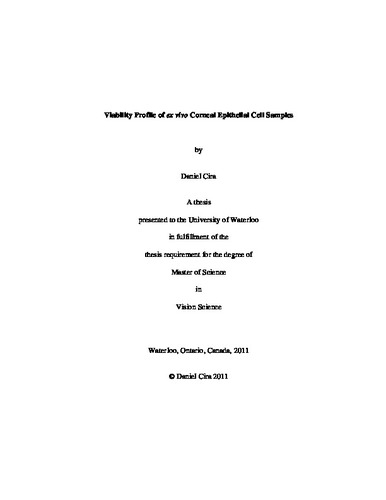Viability Profile of ex vivo Corneal Epithelial Cell Samples
| dc.contributor.author | Cira, Daniel | |
| dc.date.accessioned | 2011-10-28 19:19:54 (GMT) | |
| dc.date.available | 2011-10-28 19:19:54 (GMT) | |
| dc.date.issued | 2011-10-28T19:19:54Z | |
| dc.date.submitted | 2011 | |
| dc.identifier.uri | http://hdl.handle.net/10012/6380 | |
| dc.description.abstract | The corneal epithelium is a vital tissue which must retain its integrity to preserve vision and protect against harmful bacterial infections and other insults. Corneal disease represents the second most common cause of world blindness after cataract.1 Examination of this tissue is therefore important in any ophthalmic routine, and in particular in contact lens practice where an increased number of factors, such as lens material, lens fit, care solution and contamination may directly affect its integrity. The ocular surface cell collection apparatus (OSCCA) allows safe and efficacious collection of human corneal epithelial cells2 and may provide the ability to examine cytological changes to the human cornea during lens wear. The overall objective of this project was to demonstrate the efficacy and reliability of the OSCCA as a tool to collect human corneal epithelial cells and examine cytological changes to the human cornea. This was achieved by characterizing the phenotype and viability status of cells collected from the ocular surface using the OSCCA and by comparing the obtained results with samples collected using other non-invasive techniques. There was a high level of uncertainty whether or not the cells collected were in fact corneal or conjunctival epithelial cells. Chapter 2 and 3 showed the Hoechst and PI were not optimal stains to measure the viability status of cells collected with the OSCCA because there was an unanticipated overlap of the fluorescence from PI+ nucleated cells into the blue spectrum and the Hoechst stained both live and dead cells. Chapter 4 looked at other cytological stains and concluded that the LIVE⁄DEAD® Viability⁄Cytotoxicity Kit (calcein AM/ethidium homodimer-1) was the most appropriate stain to use with the OSCCA collected cells due to the lack of overlap between stains. Chapter 3 showed that cells that stained with sodium fluorescein stained with only Hoechst and not PI. Since Hoechst stains live and early apoptotic cells and PI stains cells that are late stage apoptotic, necrotic and dead cells, we can conclude that sodium fluorescein stains live and early apoptotic cells. Similarly in chapter 5 it was found that cells that stained with sodium fluorescein stained exclusively with calcein blue AM and not ethidium homodimer-1. | en |
| dc.language.iso | en | en |
| dc.publisher | University of Waterloo | en |
| dc.subject | corneal | en |
| dc.subject | staining | en |
| dc.subject | viability | en |
| dc.title | Viability Profile of ex vivo Corneal Epithelial Cell Samples | en |
| dc.type | Master Thesis | en |
| dc.pending | false | en |
| dc.subject.program | Vision Science | en |
| uws-etd.degree.department | School of Optometry | en |
| uws-etd.degree | Master of Science | en |
| uws.typeOfResource | Text | en |
| uws.peerReviewStatus | Unreviewed | en |
| uws.scholarLevel | Graduate | en |

